University: Organizational Change Management Report Analysis
VerifiedAdded on 2021/05/31
|12
|2894
|41
Report
AI Summary
This report provides a comprehensive literature review on organizational change management, examining the critical role of management during times of transition. It defines change management, outlining processes such as resource reallocation and business style adjustments, and emphasizes its significance during organizational crises. The report highlights the importance of effective communication, employee support, coaching, and leadership from management. It analyzes the existing literature, identifies research gaps, and critiques the current understanding of organizational change, specifically the role of management teams. The review considers various scholarly articles, their themes, methodologies and samples used, and concludes with an assessment of the review's strengths and weaknesses, including its reliance on textbooks and journals, and its limited inclusion of organizational change models. The report underscores the importance of effective change management for enhancing overall organizational performance.
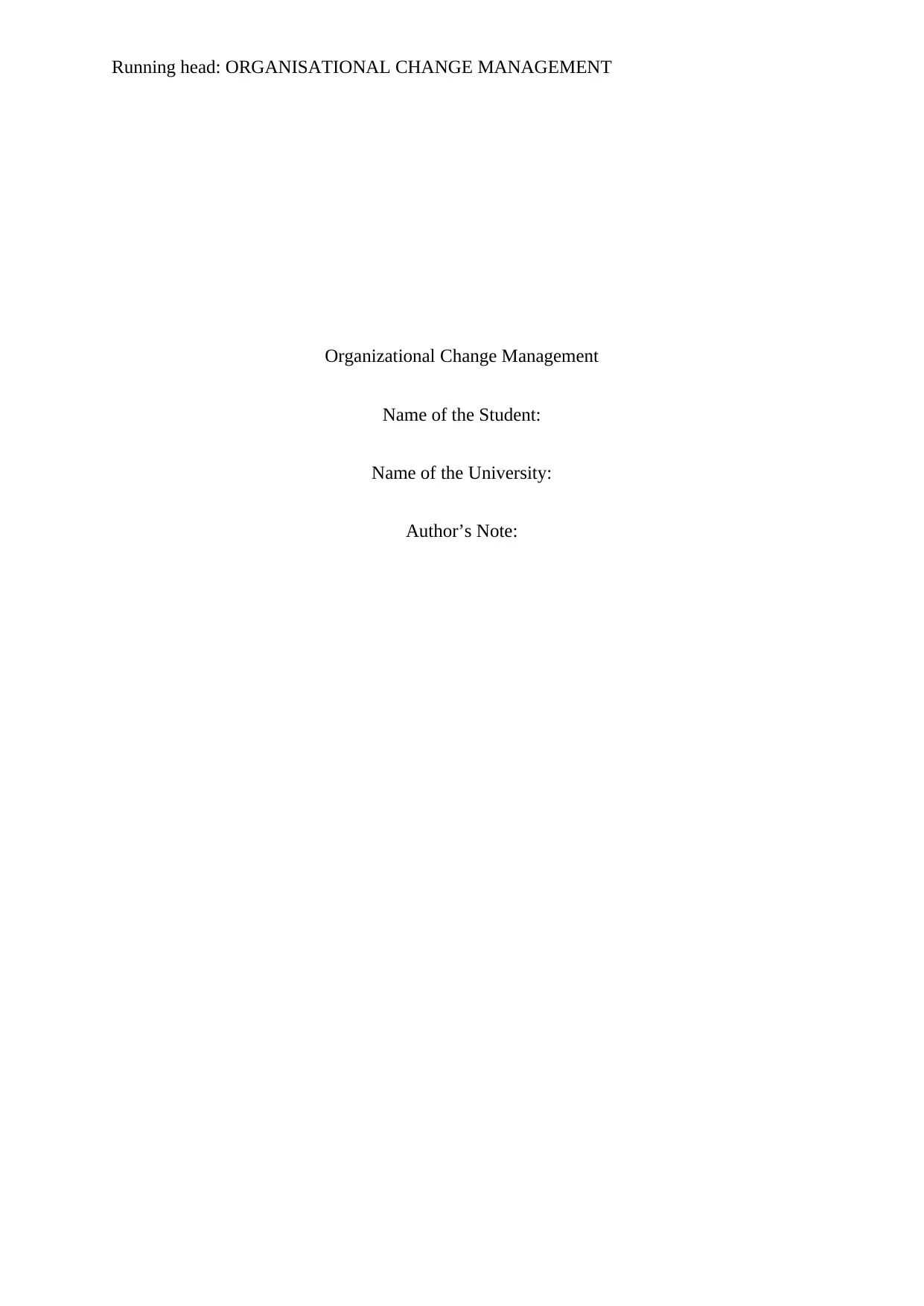
Running head: ORGANISATIONAL CHANGE MANAGEMENT
Organizational Change Management
Name of the Student:
Name of the University:
Author’s Note:
Organizational Change Management
Name of the Student:
Name of the University:
Author’s Note:
Paraphrase This Document
Need a fresh take? Get an instant paraphrase of this document with our AI Paraphraser
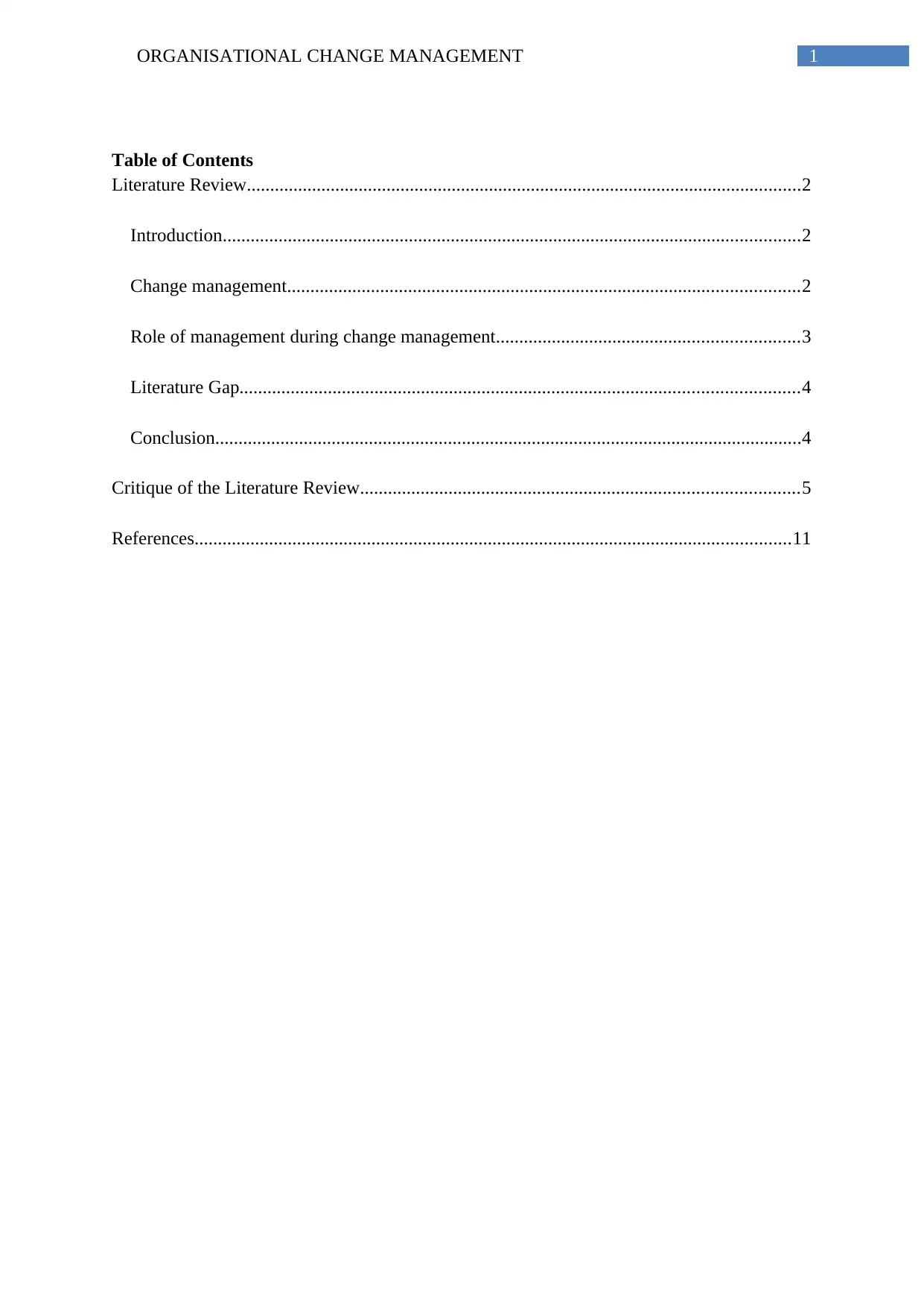
1ORGANISATIONAL CHANGE MANAGEMENT
Table of Contents
Literature Review.......................................................................................................................2
Introduction............................................................................................................................2
Change management..............................................................................................................2
Role of management during change management.................................................................3
Literature Gap........................................................................................................................4
Conclusion..............................................................................................................................4
Critique of the Literature Review..............................................................................................5
References................................................................................................................................11
Table of Contents
Literature Review.......................................................................................................................2
Introduction............................................................................................................................2
Change management..............................................................................................................2
Role of management during change management.................................................................3
Literature Gap........................................................................................................................4
Conclusion..............................................................................................................................4
Critique of the Literature Review..............................................................................................5
References................................................................................................................................11
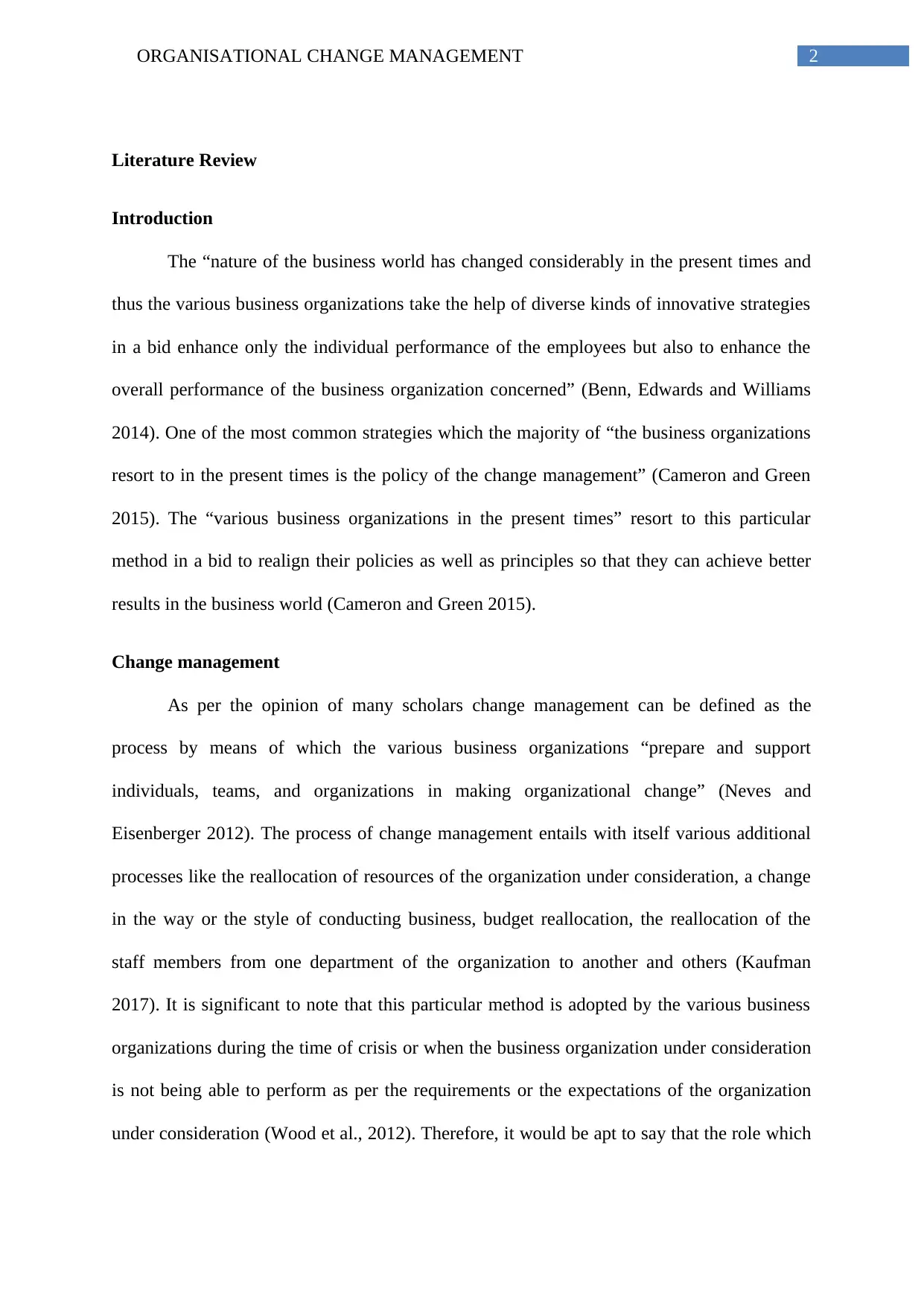
2ORGANISATIONAL CHANGE MANAGEMENT
Literature Review
Introduction
The “nature of the business world has changed considerably in the present times and
thus the various business organizations take the help of diverse kinds of innovative strategies
in a bid enhance only the individual performance of the employees but also to enhance the
overall performance of the business organization concerned” (Benn, Edwards and Williams
2014). One of the most common strategies which the majority of “the business organizations
resort to in the present times is the policy of the change management” (Cameron and Green
2015). The “various business organizations in the present times” resort to this particular
method in a bid to realign their policies as well as principles so that they can achieve better
results in the business world (Cameron and Green 2015).
Change management
As per the opinion of many scholars change management can be defined as the
process by means of which the various business organizations “prepare and support
individuals, teams, and organizations in making organizational change” (Neves and
Eisenberger 2012). The process of change management entails with itself various additional
processes like the reallocation of resources of the organization under consideration, a change
in the way or the style of conducting business, budget reallocation, the reallocation of the
staff members from one department of the organization to another and others (Kaufman
2017). It is significant to note that this particular method is adopted by the various business
organizations during the time of crisis or when the business organization under consideration
is not being able to perform as per the requirements or the expectations of the organization
under consideration (Wood et al., 2012). Therefore, it would be apt to say that the role which
Literature Review
Introduction
The “nature of the business world has changed considerably in the present times and
thus the various business organizations take the help of diverse kinds of innovative strategies
in a bid enhance only the individual performance of the employees but also to enhance the
overall performance of the business organization concerned” (Benn, Edwards and Williams
2014). One of the most common strategies which the majority of “the business organizations
resort to in the present times is the policy of the change management” (Cameron and Green
2015). The “various business organizations in the present times” resort to this particular
method in a bid to realign their policies as well as principles so that they can achieve better
results in the business world (Cameron and Green 2015).
Change management
As per the opinion of many scholars change management can be defined as the
process by means of which the various business organizations “prepare and support
individuals, teams, and organizations in making organizational change” (Neves and
Eisenberger 2012). The process of change management entails with itself various additional
processes like the reallocation of resources of the organization under consideration, a change
in the way or the style of conducting business, budget reallocation, the reallocation of the
staff members from one department of the organization to another and others (Kaufman
2017). It is significant to note that this particular method is adopted by the various business
organizations during the time of crisis or when the business organization under consideration
is not being able to perform as per the requirements or the expectations of the organization
under consideration (Wood et al., 2012). Therefore, it would be apt to say that the role which
⊘ This is a preview!⊘
Do you want full access?
Subscribe today to unlock all pages.

Trusted by 1+ million students worldwide
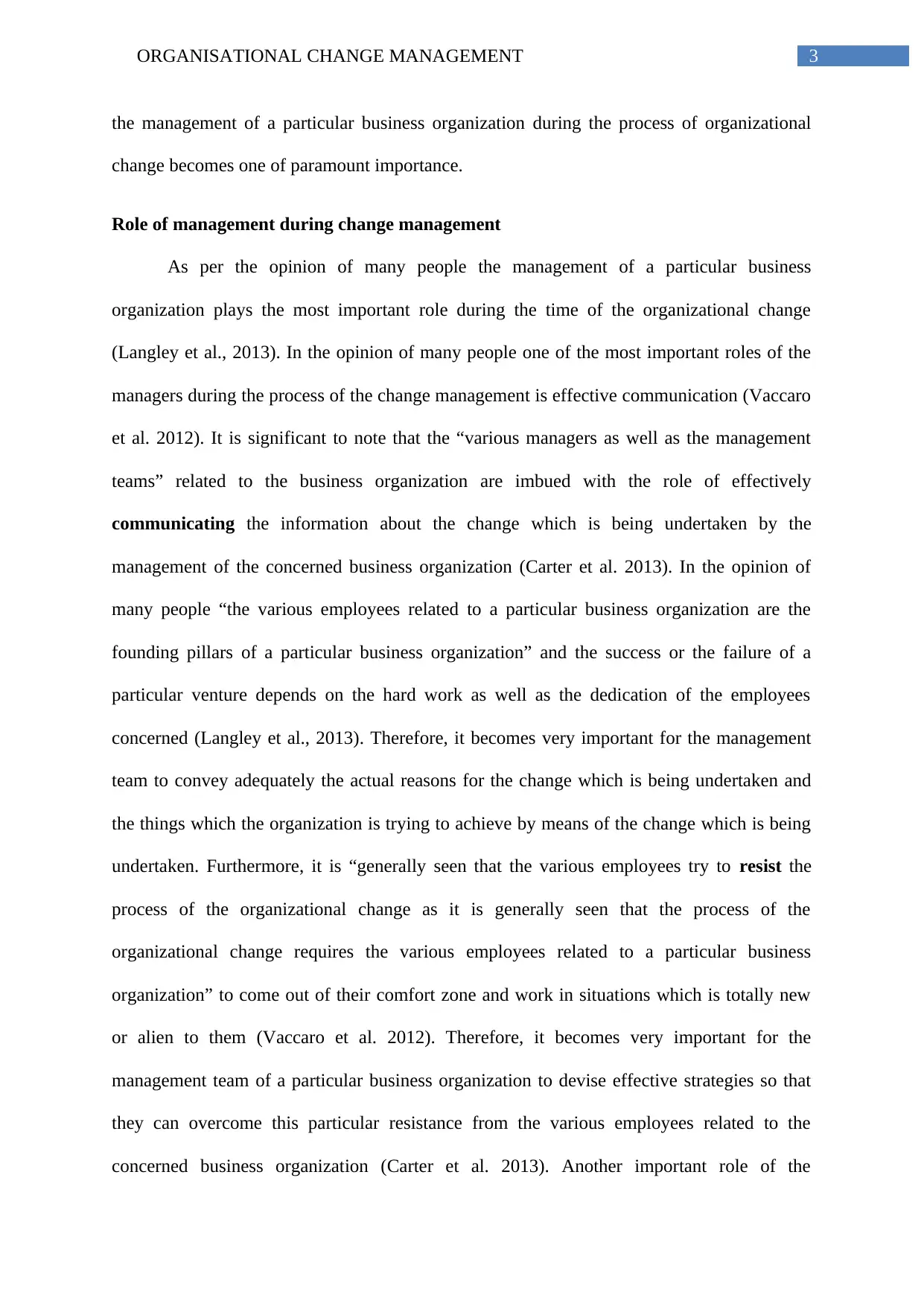
3ORGANISATIONAL CHANGE MANAGEMENT
the management of a particular business organization during the process of organizational
change becomes one of paramount importance.
Role of management during change management
As per the opinion of many people the management of a particular business
organization plays the most important role during the time of the organizational change
(Langley et al., 2013). In the opinion of many people one of the most important roles of the
managers during the process of the change management is effective communication (Vaccaro
et al. 2012). It is significant to note that the “various managers as well as the management
teams” related to the business organization are imbued with the role of effectively
communicating the information about the change which is being undertaken by the
management of the concerned business organization (Carter et al. 2013). In the opinion of
many people “the various employees related to a particular business organization are the
founding pillars of a particular business organization” and the success or the failure of a
particular venture depends on the hard work as well as the dedication of the employees
concerned (Langley et al., 2013). Therefore, it becomes very important for the management
team to convey adequately the actual reasons for the change which is being undertaken and
the things which the organization is trying to achieve by means of the change which is being
undertaken. Furthermore, it is “generally seen that the various employees try to resist the
process of the organizational change as it is generally seen that the process of the
organizational change requires the various employees related to a particular business
organization” to come out of their comfort zone and work in situations which is totally new
or alien to them (Vaccaro et al. 2012). Therefore, it becomes very important for the
management team of a particular business organization to devise effective strategies so that
they can overcome this particular resistance from the various employees related to the
concerned business organization (Carter et al. 2013). Another important role of the
the management of a particular business organization during the process of organizational
change becomes one of paramount importance.
Role of management during change management
As per the opinion of many people the management of a particular business
organization plays the most important role during the time of the organizational change
(Langley et al., 2013). In the opinion of many people one of the most important roles of the
managers during the process of the change management is effective communication (Vaccaro
et al. 2012). It is significant to note that the “various managers as well as the management
teams” related to the business organization are imbued with the role of effectively
communicating the information about the change which is being undertaken by the
management of the concerned business organization (Carter et al. 2013). In the opinion of
many people “the various employees related to a particular business organization are the
founding pillars of a particular business organization” and the success or the failure of a
particular venture depends on the hard work as well as the dedication of the employees
concerned (Langley et al., 2013). Therefore, it becomes very important for the management
team to convey adequately the actual reasons for the change which is being undertaken and
the things which the organization is trying to achieve by means of the change which is being
undertaken. Furthermore, it is “generally seen that the various employees try to resist the
process of the organizational change as it is generally seen that the process of the
organizational change requires the various employees related to a particular business
organization” to come out of their comfort zone and work in situations which is totally new
or alien to them (Vaccaro et al. 2012). Therefore, it becomes very important for the
management team of a particular business organization to devise effective strategies so that
they can overcome this particular resistance from the various employees related to the
concerned business organization (Carter et al. 2013). Another important role of the
Paraphrase This Document
Need a fresh take? Get an instant paraphrase of this document with our AI Paraphraser
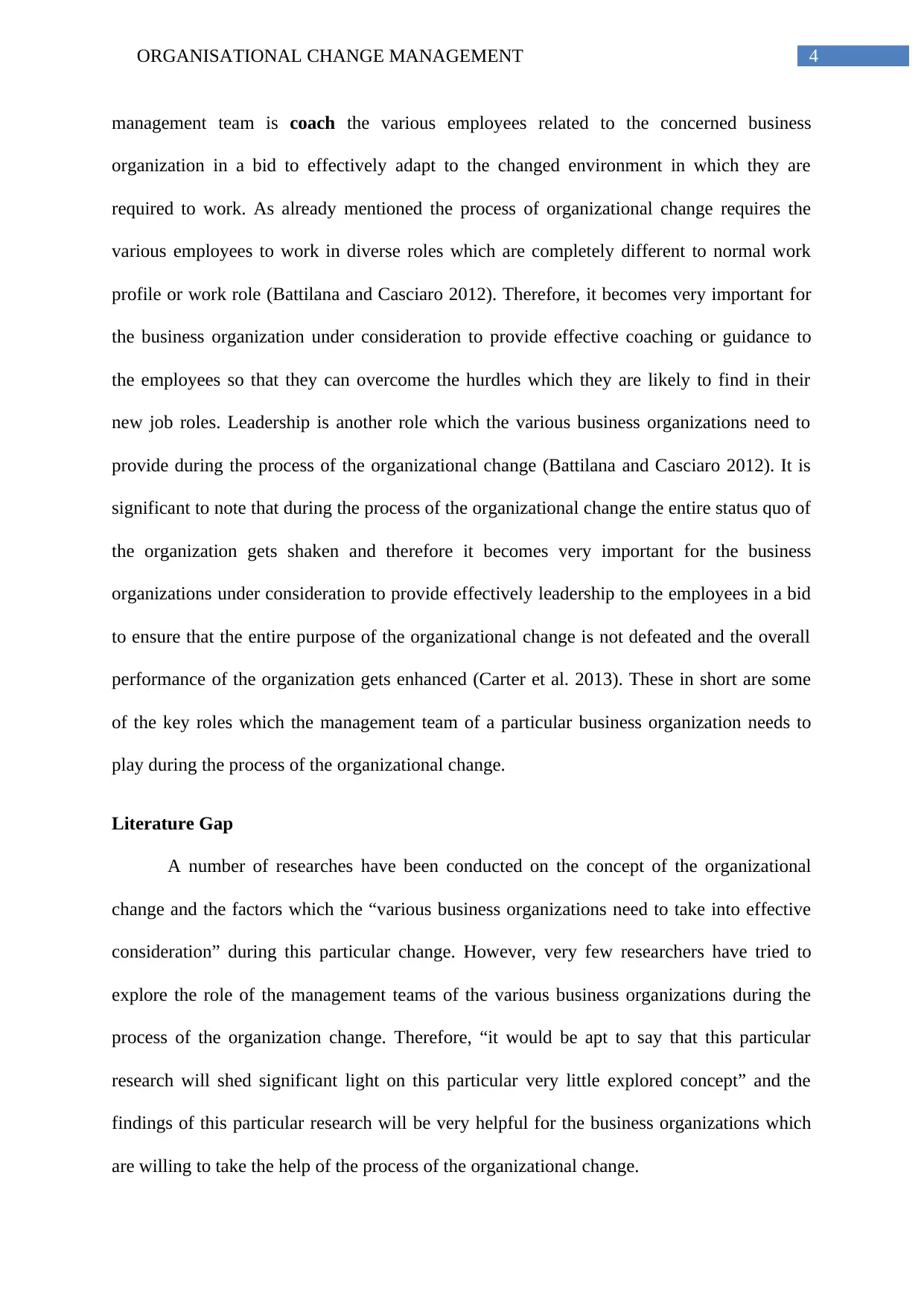
4ORGANISATIONAL CHANGE MANAGEMENT
management team is coach the various employees related to the concerned business
organization in a bid to effectively adapt to the changed environment in which they are
required to work. As already mentioned the process of organizational change requires the
various employees to work in diverse roles which are completely different to normal work
profile or work role (Battilana and Casciaro 2012). Therefore, it becomes very important for
the business organization under consideration to provide effective coaching or guidance to
the employees so that they can overcome the hurdles which they are likely to find in their
new job roles. Leadership is another role which the various business organizations need to
provide during the process of the organizational change (Battilana and Casciaro 2012). It is
significant to note that during the process of the organizational change the entire status quo of
the organization gets shaken and therefore it becomes very important for the business
organizations under consideration to provide effectively leadership to the employees in a bid
to ensure that the entire purpose of the organizational change is not defeated and the overall
performance of the organization gets enhanced (Carter et al. 2013). These in short are some
of the key roles which the management team of a particular business organization needs to
play during the process of the organizational change.
Literature Gap
A number of researches have been conducted on the concept of the organizational
change and the factors which the “various business organizations need to take into effective
consideration” during this particular change. However, very few researchers have tried to
explore the role of the management teams of the various business organizations during the
process of the organization change. Therefore, “it would be apt to say that this particular
research will shed significant light on this particular very little explored concept” and the
findings of this particular research will be very helpful for the business organizations which
are willing to take the help of the process of the organizational change.
management team is coach the various employees related to the concerned business
organization in a bid to effectively adapt to the changed environment in which they are
required to work. As already mentioned the process of organizational change requires the
various employees to work in diverse roles which are completely different to normal work
profile or work role (Battilana and Casciaro 2012). Therefore, it becomes very important for
the business organization under consideration to provide effective coaching or guidance to
the employees so that they can overcome the hurdles which they are likely to find in their
new job roles. Leadership is another role which the various business organizations need to
provide during the process of the organizational change (Battilana and Casciaro 2012). It is
significant to note that during the process of the organizational change the entire status quo of
the organization gets shaken and therefore it becomes very important for the business
organizations under consideration to provide effectively leadership to the employees in a bid
to ensure that the entire purpose of the organizational change is not defeated and the overall
performance of the organization gets enhanced (Carter et al. 2013). These in short are some
of the key roles which the management team of a particular business organization needs to
play during the process of the organizational change.
Literature Gap
A number of researches have been conducted on the concept of the organizational
change and the factors which the “various business organizations need to take into effective
consideration” during this particular change. However, very few researchers have tried to
explore the role of the management teams of the various business organizations during the
process of the organization change. Therefore, “it would be apt to say that this particular
research will shed significant light on this particular very little explored concept” and the
findings of this particular research will be very helpful for the business organizations which
are willing to take the help of the process of the organizational change.
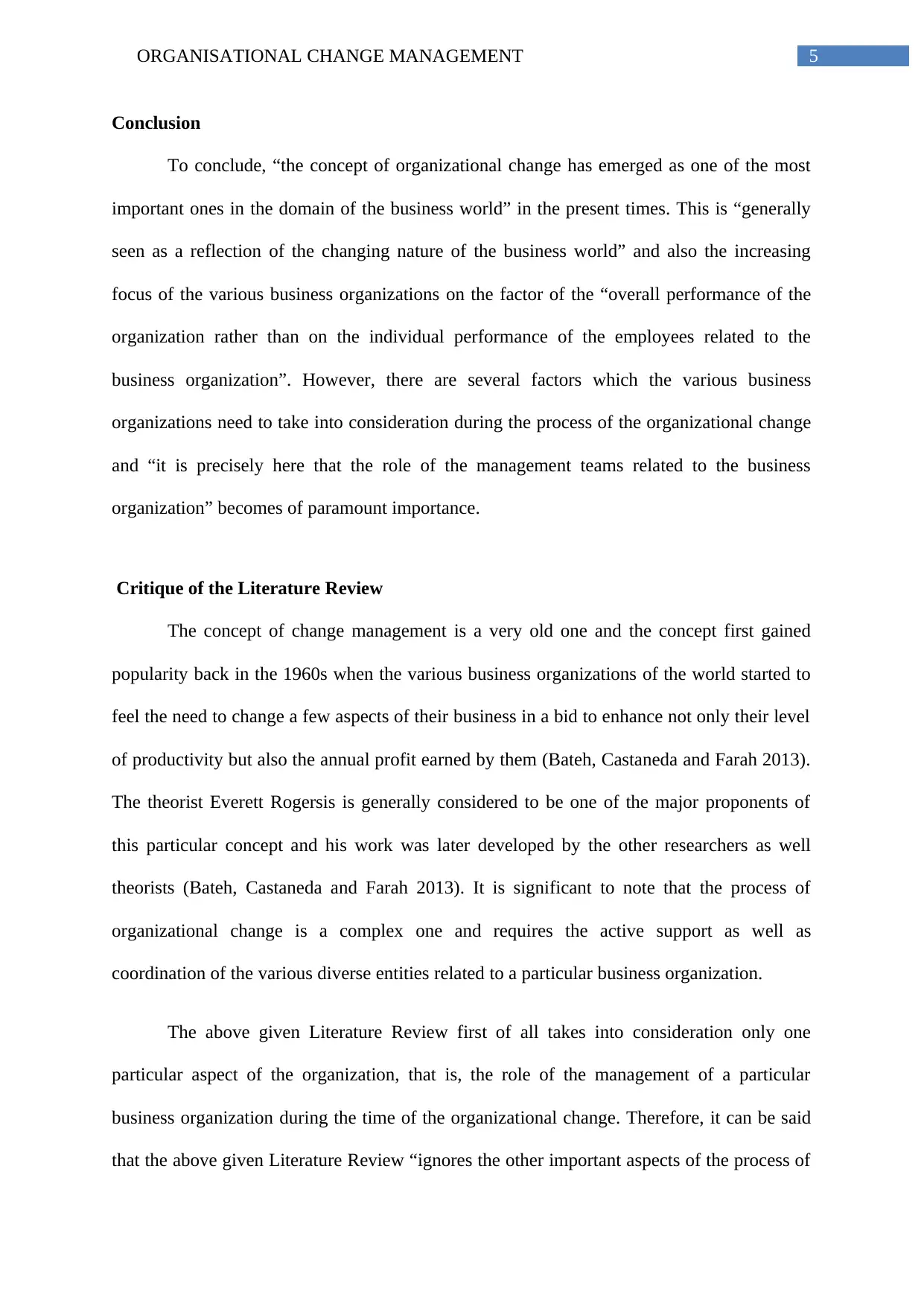
5ORGANISATIONAL CHANGE MANAGEMENT
Conclusion
To conclude, “the concept of organizational change has emerged as one of the most
important ones in the domain of the business world” in the present times. This is “generally
seen as a reflection of the changing nature of the business world” and also the increasing
focus of the various business organizations on the factor of the “overall performance of the
organization rather than on the individual performance of the employees related to the
business organization”. However, there are several factors which the various business
organizations need to take into consideration during the process of the organizational change
and “it is precisely here that the role of the management teams related to the business
organization” becomes of paramount importance.
Critique of the Literature Review
The concept of change management is a very old one and the concept first gained
popularity back in the 1960s when the various business organizations of the world started to
feel the need to change a few aspects of their business in a bid to enhance not only their level
of productivity but also the annual profit earned by them (Bateh, Castaneda and Farah 2013).
The theorist Everett Rogersis is generally considered to be one of the major proponents of
this particular concept and his work was later developed by the other researchers as well
theorists (Bateh, Castaneda and Farah 2013). It is significant to note that the process of
organizational change is a complex one and requires the active support as well as
coordination of the various diverse entities related to a particular business organization.
The above given Literature Review first of all takes into consideration only one
particular aspect of the organization, that is, the role of the management of a particular
business organization during the time of the organizational change. Therefore, it can be said
that the above given Literature Review “ignores the other important aspects of the process of
Conclusion
To conclude, “the concept of organizational change has emerged as one of the most
important ones in the domain of the business world” in the present times. This is “generally
seen as a reflection of the changing nature of the business world” and also the increasing
focus of the various business organizations on the factor of the “overall performance of the
organization rather than on the individual performance of the employees related to the
business organization”. However, there are several factors which the various business
organizations need to take into consideration during the process of the organizational change
and “it is precisely here that the role of the management teams related to the business
organization” becomes of paramount importance.
Critique of the Literature Review
The concept of change management is a very old one and the concept first gained
popularity back in the 1960s when the various business organizations of the world started to
feel the need to change a few aspects of their business in a bid to enhance not only their level
of productivity but also the annual profit earned by them (Bateh, Castaneda and Farah 2013).
The theorist Everett Rogersis is generally considered to be one of the major proponents of
this particular concept and his work was later developed by the other researchers as well
theorists (Bateh, Castaneda and Farah 2013). It is significant to note that the process of
organizational change is a complex one and requires the active support as well as
coordination of the various diverse entities related to a particular business organization.
The above given Literature Review first of all takes into consideration only one
particular aspect of the organization, that is, the role of the management of a particular
business organization during the time of the organizational change. Therefore, it can be said
that the above given Literature Review “ignores the other important aspects of the process of
⊘ This is a preview!⊘
Do you want full access?
Subscribe today to unlock all pages.

Trusted by 1+ million students worldwide
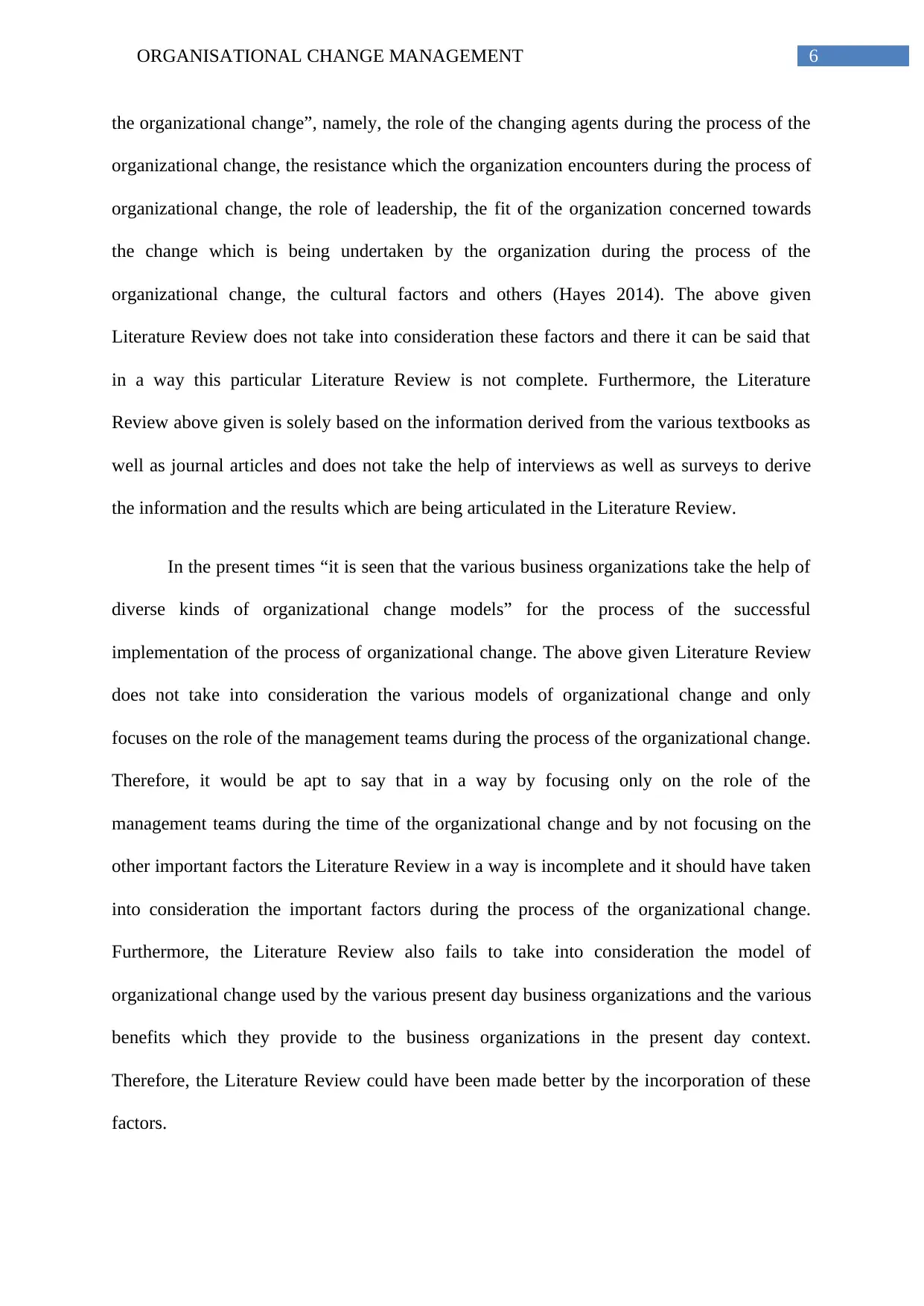
6ORGANISATIONAL CHANGE MANAGEMENT
the organizational change”, namely, the role of the changing agents during the process of the
organizational change, the resistance which the organization encounters during the process of
organizational change, the role of leadership, the fit of the organization concerned towards
the change which is being undertaken by the organization during the process of the
organizational change, the cultural factors and others (Hayes 2014). The above given
Literature Review does not take into consideration these factors and there it can be said that
in a way this particular Literature Review is not complete. Furthermore, the Literature
Review above given is solely based on the information derived from the various textbooks as
well as journal articles and does not take the help of interviews as well as surveys to derive
the information and the results which are being articulated in the Literature Review.
In the present times “it is seen that the various business organizations take the help of
diverse kinds of organizational change models” for the process of the successful
implementation of the process of organizational change. The above given Literature Review
does not take into consideration the various models of organizational change and only
focuses on the role of the management teams during the process of the organizational change.
Therefore, it would be apt to say that in a way by focusing only on the role of the
management teams during the time of the organizational change and by not focusing on the
other important factors the Literature Review in a way is incomplete and it should have taken
into consideration the important factors during the process of the organizational change.
Furthermore, the Literature Review also fails to take into consideration the model of
organizational change used by the various present day business organizations and the various
benefits which they provide to the business organizations in the present day context.
Therefore, the Literature Review could have been made better by the incorporation of these
factors.
the organizational change”, namely, the role of the changing agents during the process of the
organizational change, the resistance which the organization encounters during the process of
organizational change, the role of leadership, the fit of the organization concerned towards
the change which is being undertaken by the organization during the process of the
organizational change, the cultural factors and others (Hayes 2014). The above given
Literature Review does not take into consideration these factors and there it can be said that
in a way this particular Literature Review is not complete. Furthermore, the Literature
Review above given is solely based on the information derived from the various textbooks as
well as journal articles and does not take the help of interviews as well as surveys to derive
the information and the results which are being articulated in the Literature Review.
In the present times “it is seen that the various business organizations take the help of
diverse kinds of organizational change models” for the process of the successful
implementation of the process of organizational change. The above given Literature Review
does not take into consideration the various models of organizational change and only
focuses on the role of the management teams during the process of the organizational change.
Therefore, it would be apt to say that in a way by focusing only on the role of the
management teams during the time of the organizational change and by not focusing on the
other important factors the Literature Review in a way is incomplete and it should have taken
into consideration the important factors during the process of the organizational change.
Furthermore, the Literature Review also fails to take into consideration the model of
organizational change used by the various present day business organizations and the various
benefits which they provide to the business organizations in the present day context.
Therefore, the Literature Review could have been made better by the incorporation of these
factors.
Paraphrase This Document
Need a fresh take? Get an instant paraphrase of this document with our AI Paraphraser
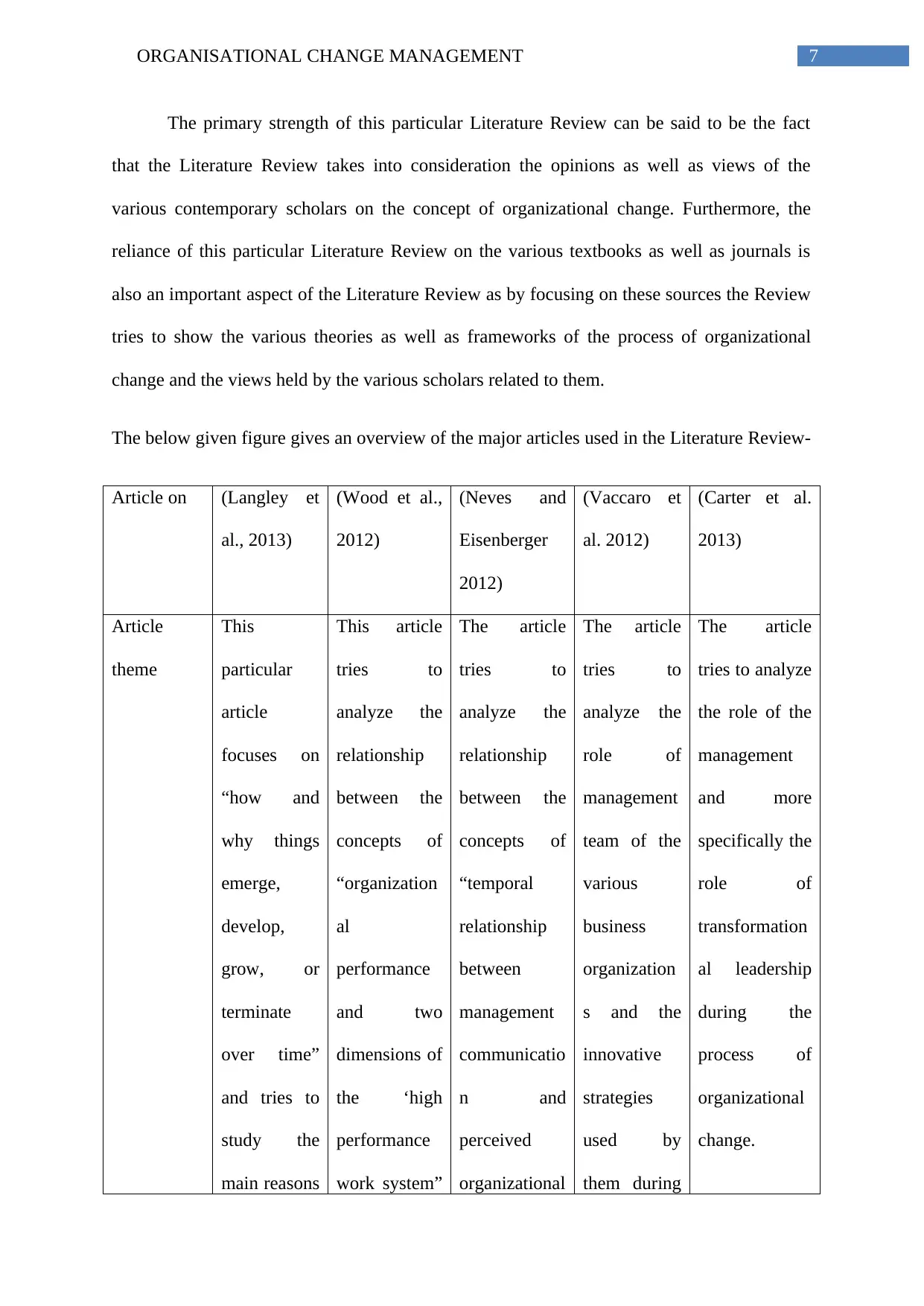
7ORGANISATIONAL CHANGE MANAGEMENT
The primary strength of this particular Literature Review can be said to be the fact
that the Literature Review takes into consideration the opinions as well as views of the
various contemporary scholars on the concept of organizational change. Furthermore, the
reliance of this particular Literature Review on the various textbooks as well as journals is
also an important aspect of the Literature Review as by focusing on these sources the Review
tries to show the various theories as well as frameworks of the process of organizational
change and the views held by the various scholars related to them.
The below given figure gives an overview of the major articles used in the Literature Review-
Article on (Langley et
al., 2013)
(Wood et al.,
2012)
(Neves and
Eisenberger
2012)
(Vaccaro et
al. 2012)
(Carter et al.
2013)
Article
theme
This
particular
article
focuses on
“how and
why things
emerge,
develop,
grow, or
terminate
over time”
and tries to
study the
main reasons
This article
tries to
analyze the
relationship
between the
concepts of
“organization
al
performance
and two
dimensions of
the ‘high
performance
work system”
The article
tries to
analyze the
relationship
between the
concepts of
“temporal
relationship
between
management
communicatio
n and
perceived
organizational
The article
tries to
analyze the
role of
management
team of the
various
business
organization
s and the
innovative
strategies
used by
them during
The article
tries to analyze
the role of the
management
and more
specifically the
role of
transformation
al leadership
during the
process of
organizational
change.
The primary strength of this particular Literature Review can be said to be the fact
that the Literature Review takes into consideration the opinions as well as views of the
various contemporary scholars on the concept of organizational change. Furthermore, the
reliance of this particular Literature Review on the various textbooks as well as journals is
also an important aspect of the Literature Review as by focusing on these sources the Review
tries to show the various theories as well as frameworks of the process of organizational
change and the views held by the various scholars related to them.
The below given figure gives an overview of the major articles used in the Literature Review-
Article on (Langley et
al., 2013)
(Wood et al.,
2012)
(Neves and
Eisenberger
2012)
(Vaccaro et
al. 2012)
(Carter et al.
2013)
Article
theme
This
particular
article
focuses on
“how and
why things
emerge,
develop,
grow, or
terminate
over time”
and tries to
study the
main reasons
This article
tries to
analyze the
relationship
between the
concepts of
“organization
al
performance
and two
dimensions of
the ‘high
performance
work system”
The article
tries to
analyze the
relationship
between the
concepts of
“temporal
relationship
between
management
communicatio
n and
perceived
organizational
The article
tries to
analyze the
role of
management
team of the
various
business
organization
s and the
innovative
strategies
used by
them during
The article
tries to analyze
the role of the
management
and more
specifically the
role of
transformation
al leadership
during the
process of
organizational
change.
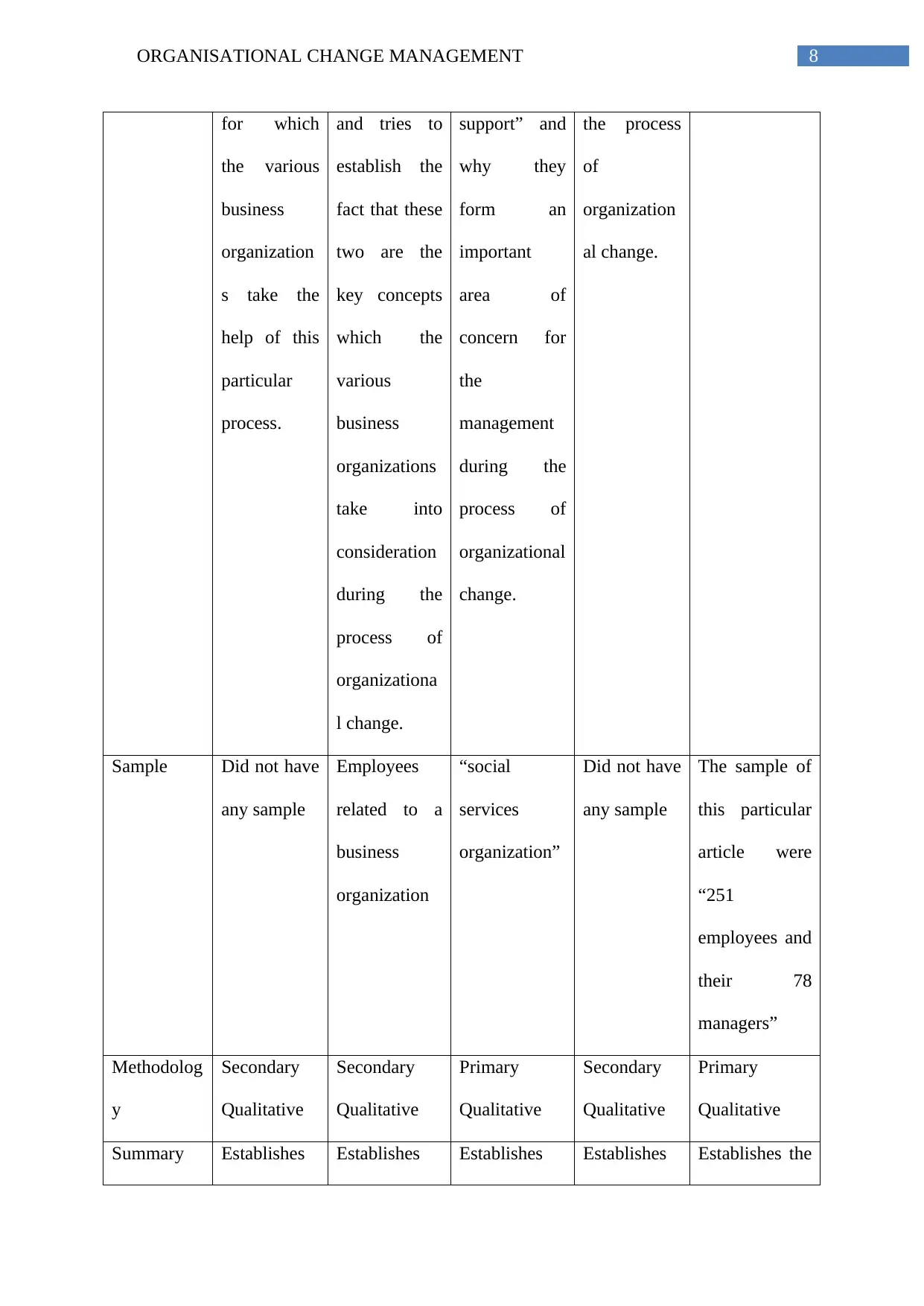
8ORGANISATIONAL CHANGE MANAGEMENT
for which
the various
business
organization
s take the
help of this
particular
process.
and tries to
establish the
fact that these
two are the
key concepts
which the
various
business
organizations
take into
consideration
during the
process of
organizationa
l change.
support” and
why they
form an
important
area of
concern for
the
management
during the
process of
organizational
change.
the process
of
organization
al change.
Sample Did not have
any sample
Employees
related to a
business
organization
“social
services
organization”
Did not have
any sample
The sample of
this particular
article were
“251
employees and
their 78
managers”
Methodolog
y
Secondary
Qualitative
Secondary
Qualitative
Primary
Qualitative
Secondary
Qualitative
Primary
Qualitative
Summary Establishes Establishes Establishes Establishes Establishes the
for which
the various
business
organization
s take the
help of this
particular
process.
and tries to
establish the
fact that these
two are the
key concepts
which the
various
business
organizations
take into
consideration
during the
process of
organizationa
l change.
support” and
why they
form an
important
area of
concern for
the
management
during the
process of
organizational
change.
the process
of
organization
al change.
Sample Did not have
any sample
Employees
related to a
business
organization
“social
services
organization”
Did not have
any sample
The sample of
this particular
article were
“251
employees and
their 78
managers”
Methodolog
y
Secondary
Qualitative
Secondary
Qualitative
Primary
Qualitative
Secondary
Qualitative
Primary
Qualitative
Summary Establishes Establishes Establishes Establishes Establishes the
⊘ This is a preview!⊘
Do you want full access?
Subscribe today to unlock all pages.

Trusted by 1+ million students worldwide
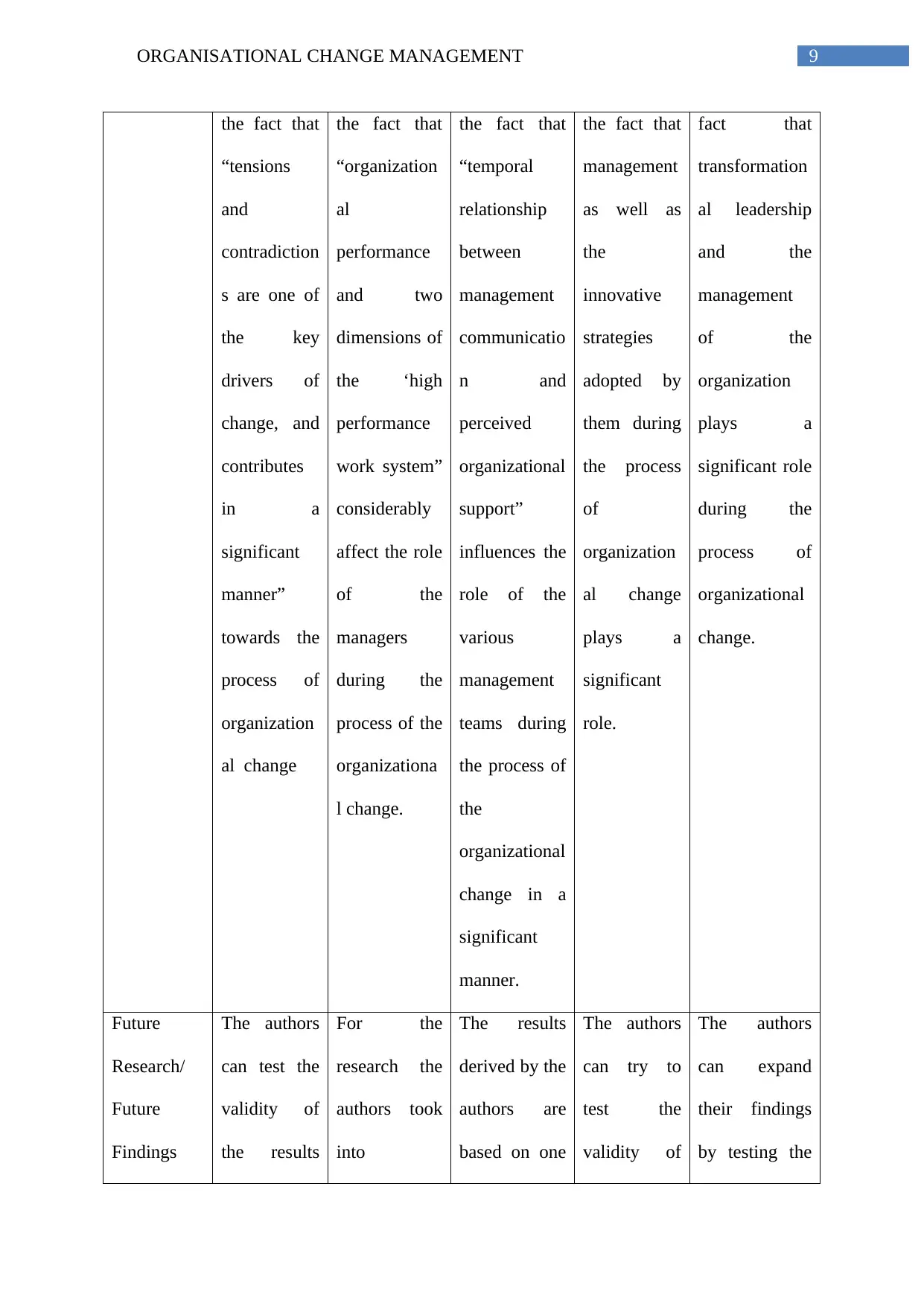
9ORGANISATIONAL CHANGE MANAGEMENT
the fact that
“tensions
and
contradiction
s are one of
the key
drivers of
change, and
contributes
in a
significant
manner”
towards the
process of
organization
al change
the fact that
“organization
al
performance
and two
dimensions of
the ‘high
performance
work system”
considerably
affect the role
of the
managers
during the
process of the
organizationa
l change.
the fact that
“temporal
relationship
between
management
communicatio
n and
perceived
organizational
support”
influences the
role of the
various
management
teams during
the process of
the
organizational
change in a
significant
manner.
the fact that
management
as well as
the
innovative
strategies
adopted by
them during
the process
of
organization
al change
plays a
significant
role.
fact that
transformation
al leadership
and the
management
of the
organization
plays a
significant role
during the
process of
organizational
change.
Future
Research/
Future
Findings
The authors
can test the
validity of
the results
For the
research the
authors took
into
The results
derived by the
authors are
based on one
The authors
can try to
test the
validity of
The authors
can expand
their findings
by testing the
the fact that
“tensions
and
contradiction
s are one of
the key
drivers of
change, and
contributes
in a
significant
manner”
towards the
process of
organization
al change
the fact that
“organization
al
performance
and two
dimensions of
the ‘high
performance
work system”
considerably
affect the role
of the
managers
during the
process of the
organizationa
l change.
the fact that
“temporal
relationship
between
management
communicatio
n and
perceived
organizational
support”
influences the
role of the
various
management
teams during
the process of
the
organizational
change in a
significant
manner.
the fact that
management
as well as
the
innovative
strategies
adopted by
them during
the process
of
organization
al change
plays a
significant
role.
fact that
transformation
al leadership
and the
management
of the
organization
plays a
significant role
during the
process of
organizational
change.
Future
Research/
Future
Findings
The authors
can test the
validity of
the results
For the
research the
authors took
into
The results
derived by the
authors are
based on one
The authors
can try to
test the
validity of
The authors
can expand
their findings
by testing the
Paraphrase This Document
Need a fresh take? Get an instant paraphrase of this document with our AI Paraphraser
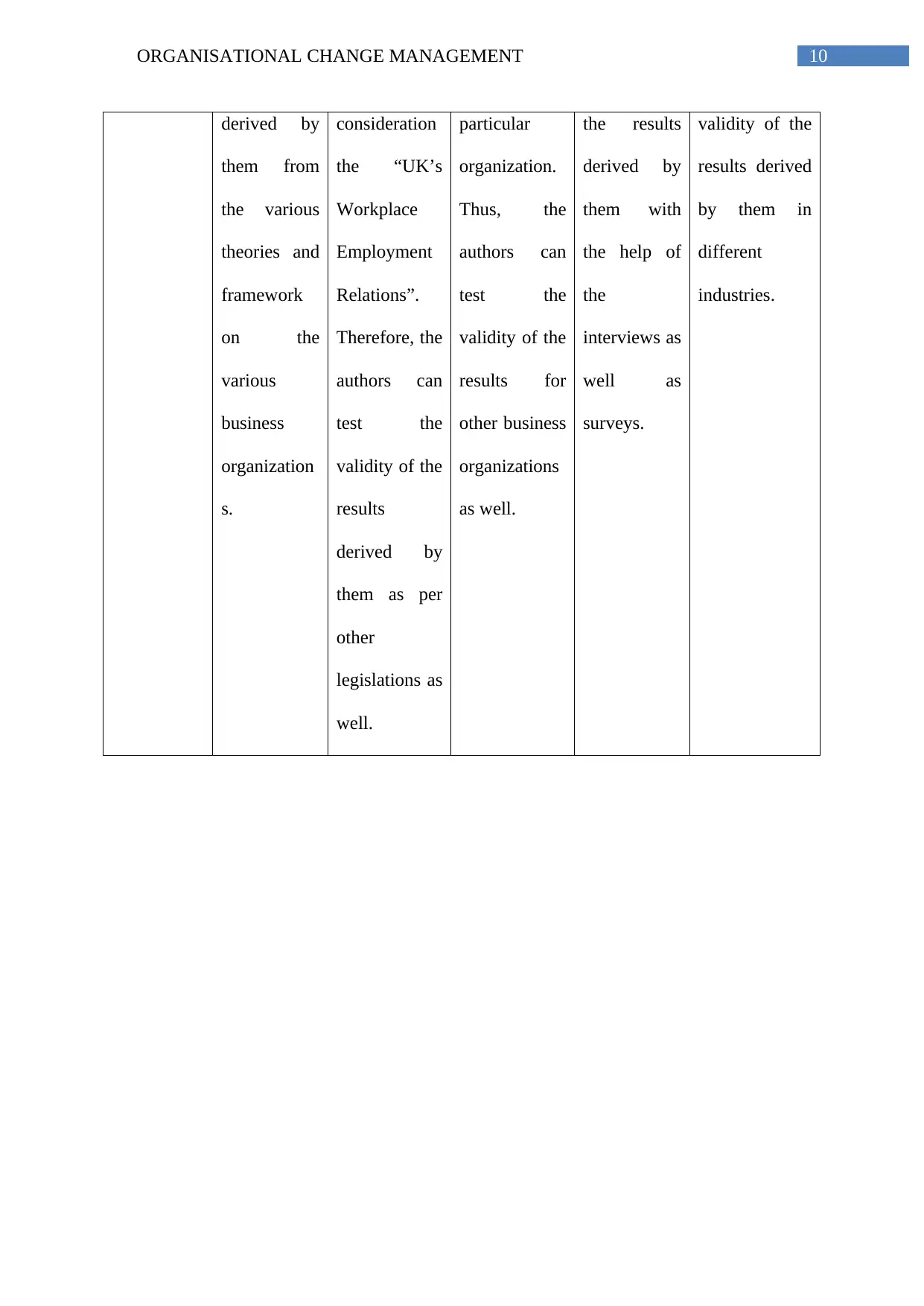
10ORGANISATIONAL CHANGE MANAGEMENT
derived by
them from
the various
theories and
framework
on the
various
business
organization
s.
consideration
the “UK’s
Workplace
Employment
Relations”.
Therefore, the
authors can
test the
validity of the
results
derived by
them as per
other
legislations as
well.
particular
organization.
Thus, the
authors can
test the
validity of the
results for
other business
organizations
as well.
the results
derived by
them with
the help of
the
interviews as
well as
surveys.
validity of the
results derived
by them in
different
industries.
derived by
them from
the various
theories and
framework
on the
various
business
organization
s.
consideration
the “UK’s
Workplace
Employment
Relations”.
Therefore, the
authors can
test the
validity of the
results
derived by
them as per
other
legislations as
well.
particular
organization.
Thus, the
authors can
test the
validity of the
results for
other business
organizations
as well.
the results
derived by
them with
the help of
the
interviews as
well as
surveys.
validity of the
results derived
by them in
different
industries.
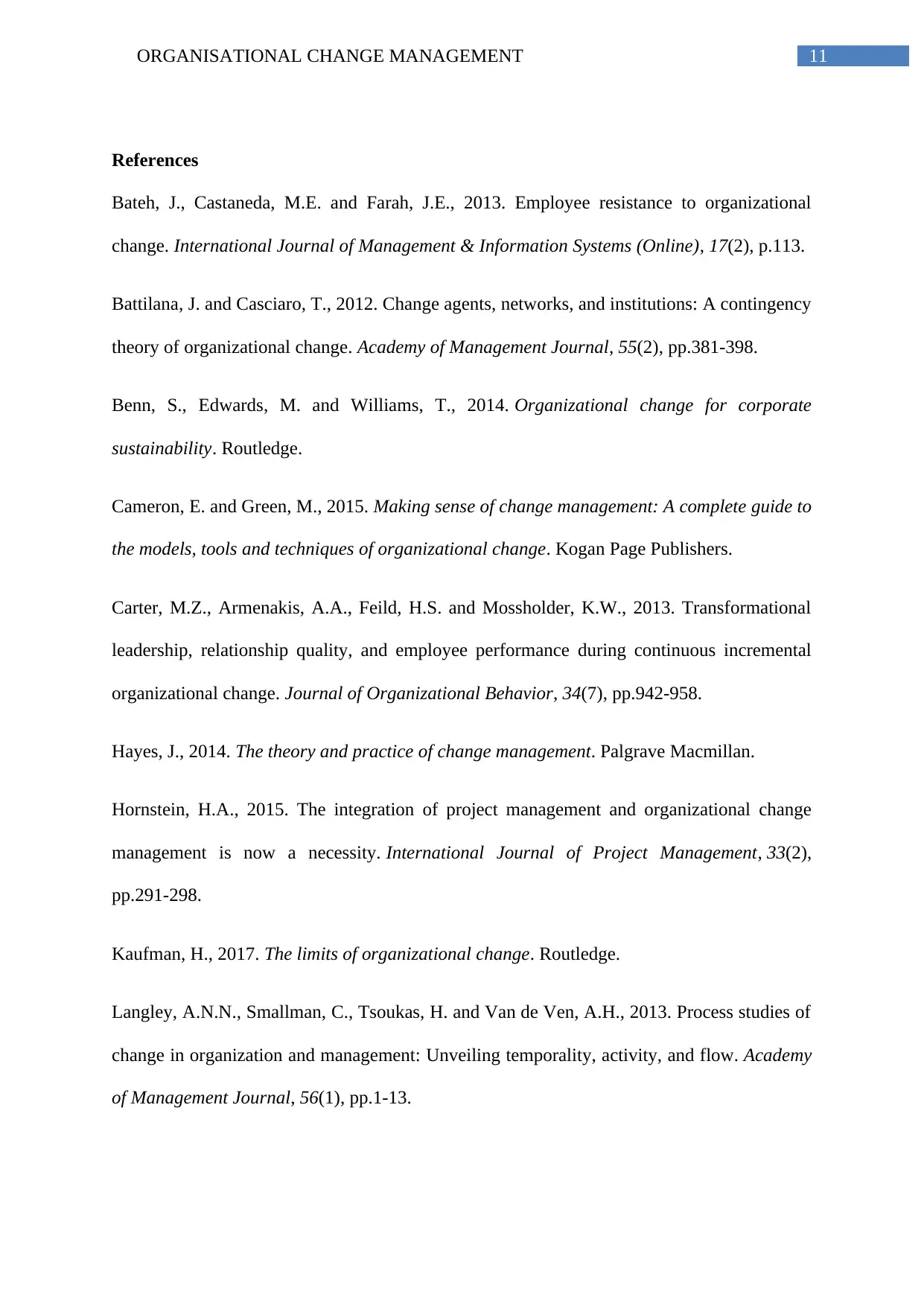
11ORGANISATIONAL CHANGE MANAGEMENT
References
Bateh, J., Castaneda, M.E. and Farah, J.E., 2013. Employee resistance to organizational
change. International Journal of Management & Information Systems (Online), 17(2), p.113.
Battilana, J. and Casciaro, T., 2012. Change agents, networks, and institutions: A contingency
theory of organizational change. Academy of Management Journal, 55(2), pp.381-398.
Benn, S., Edwards, M. and Williams, T., 2014. Organizational change for corporate
sustainability. Routledge.
Cameron, E. and Green, M., 2015. Making sense of change management: A complete guide to
the models, tools and techniques of organizational change. Kogan Page Publishers.
Carter, M.Z., Armenakis, A.A., Feild, H.S. and Mossholder, K.W., 2013. Transformational
leadership, relationship quality, and employee performance during continuous incremental
organizational change. Journal of Organizational Behavior, 34(7), pp.942-958.
Hayes, J., 2014. The theory and practice of change management. Palgrave Macmillan.
Hornstein, H.A., 2015. The integration of project management and organizational change
management is now a necessity. International Journal of Project Management, 33(2),
pp.291-298.
Kaufman, H., 2017. The limits of organizational change. Routledge.
Langley, A.N.N., Smallman, C., Tsoukas, H. and Van de Ven, A.H., 2013. Process studies of
change in organization and management: Unveiling temporality, activity, and flow. Academy
of Management Journal, 56(1), pp.1-13.
References
Bateh, J., Castaneda, M.E. and Farah, J.E., 2013. Employee resistance to organizational
change. International Journal of Management & Information Systems (Online), 17(2), p.113.
Battilana, J. and Casciaro, T., 2012. Change agents, networks, and institutions: A contingency
theory of organizational change. Academy of Management Journal, 55(2), pp.381-398.
Benn, S., Edwards, M. and Williams, T., 2014. Organizational change for corporate
sustainability. Routledge.
Cameron, E. and Green, M., 2015. Making sense of change management: A complete guide to
the models, tools and techniques of organizational change. Kogan Page Publishers.
Carter, M.Z., Armenakis, A.A., Feild, H.S. and Mossholder, K.W., 2013. Transformational
leadership, relationship quality, and employee performance during continuous incremental
organizational change. Journal of Organizational Behavior, 34(7), pp.942-958.
Hayes, J., 2014. The theory and practice of change management. Palgrave Macmillan.
Hornstein, H.A., 2015. The integration of project management and organizational change
management is now a necessity. International Journal of Project Management, 33(2),
pp.291-298.
Kaufman, H., 2017. The limits of organizational change. Routledge.
Langley, A.N.N., Smallman, C., Tsoukas, H. and Van de Ven, A.H., 2013. Process studies of
change in organization and management: Unveiling temporality, activity, and flow. Academy
of Management Journal, 56(1), pp.1-13.
⊘ This is a preview!⊘
Do you want full access?
Subscribe today to unlock all pages.

Trusted by 1+ million students worldwide
1 out of 12
Related Documents
Your All-in-One AI-Powered Toolkit for Academic Success.
+13062052269
info@desklib.com
Available 24*7 on WhatsApp / Email
![[object Object]](/_next/static/media/star-bottom.7253800d.svg)
Unlock your academic potential
Copyright © 2020–2025 A2Z Services. All Rights Reserved. Developed and managed by ZUCOL.




